
(Download a higher resolution picture by clicking on any
picture below.) 
SpaceShipOne made the first privately funded flight to an altitude of 100 kilometers from the Mojave Airport on Monday, June 21. Pilot Mike Melvill earned his astronaut's wings and experienced three minutes of weightlessness during the flight into space.
SpaceShipOne was designed by Burt Rutan and constructed by Scaled Composites Incorporated. Funding has been provided by Paul G. Allen.
Burt Rutan founded Scaled Composites, Inc. in April 1982 to develop research aircraft. The company currently employs 130 people at the Mojave, California airport.
Link to the Scaled Composites, Incorporated web site
Link to the Mojave Airport web site
The flight was a continuation of the envelope expansion phase of testing. An attempt to win the Ansari X-Prize by making two flights to 100 kilometers within a two week period is expected in the near future.
Link to the Ansari X-Prize web site The flight of SpaceShipOne was preceded by the arrival of numerous airplanes and helicopters bringing VIPs to the Mojave Airport.
 Space shuttle astronauts Ed Lu and Scott J. "Doc" Horowitz arrived in
this NASA T-38A in the pre-dawn darkness at 5:12 A.M.
Space shuttle astronauts Ed Lu and Scott J. "Doc" Horowitz arrived in
this NASA T-38A in the pre-dawn darkness at 5:12 A.M.
 Gulfstream IV, N5NG landed at 5:38 A.M. It is owned by Northrop-Grumman
Systems Corporation.
Gulfstream IV, N5NG landed at 5:38 A.M. It is owned by Northrop-Grumman
Systems Corporation.
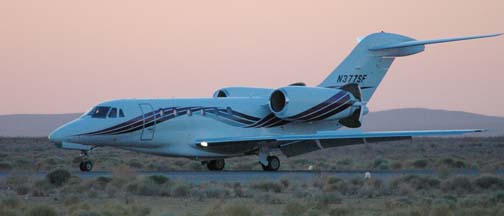 Citation X, N377SF landed at 5:46 A.M. What well known patron of Burt
Rutan and Scaled Composites has the initials SF?
Citation X, N377SF landed at 5:46 A.M. What well known patron of Burt
Rutan and Scaled Composites has the initials SF?
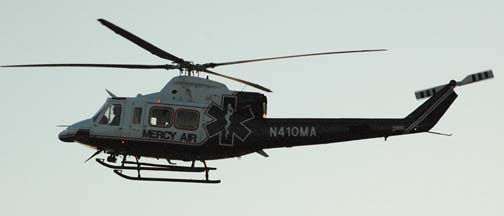 Mercy Air Bell 412, N410MA flew in just after Steve Fosset's Citation X.
Mercy Air Bell 412, N410MA flew in just after Steve Fosset's Citation X.
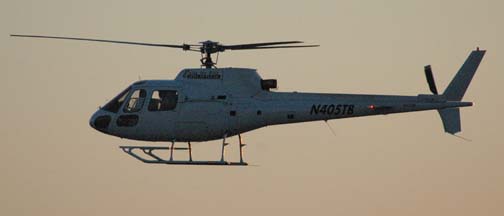 Tundra Copters Eurocopter AS 350 BA, N405TB hauled in more VIPs at 5:47 A.M.
Tundra Copters Eurocopter AS 350 BA, N405TB hauled in more VIPs at 5:47 A.M.
 Kern County Sheriff Hughes 369E, N197E patrolled the airport at 6:07 A.M.
Kern County Sheriff Hughes 369E, N197E patrolled the airport at 6:07 A.M.
 Charles Coleman's Extra 300, N12DW served as "low
chase" for the White Knight, N318SL
and SpaceShipOne. Coleman is a design engineer at
Scaled Composites. It taxied out at 6:35 A.M.
Charles Coleman's Extra 300, N12DW served as "low
chase" for the White Knight, N318SL
and SpaceShipOne. Coleman is a design engineer at
Scaled Composites. It taxied out at 6:35 A.M.
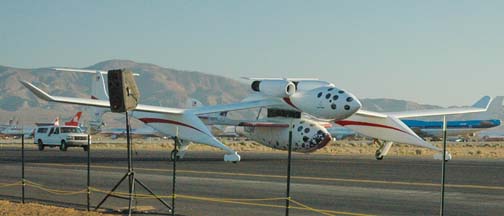 White Knight, N318SL and SpaceShipOne, N328KF taxi out at the
beginning of the mission. White Knight was piloted by Brian Binnie. SpaceShipOne
was piloted by Mike Melvill.
White Knight, N318SL and SpaceShipOne, N328KF taxi out at the
beginning of the mission. White Knight was piloted by Brian Binnie. SpaceShipOne
was piloted by Mike Melvill.
Link to the Scaled Composites, Incorporated biography of Brian Binnie
Link to the Scaled Composites, Incorporated biography of Mike Melvill
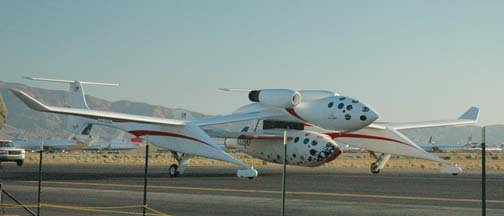 White Knight and SpaceShipOne. White Knight is named for X-15 pilots
Robert White and Pete Knight.
White Knight and SpaceShipOne. White Knight is named for X-15 pilots
Robert White and Pete Knight.
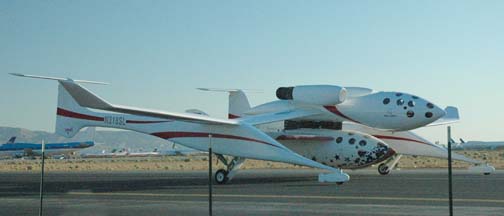 White Knight and SpaceShipOne.
White Knight and SpaceShipOne.
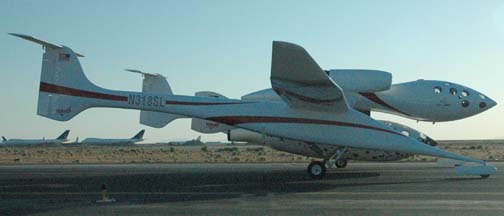 White Knight and SpaceShipOne.
White Knight and SpaceShipOne.
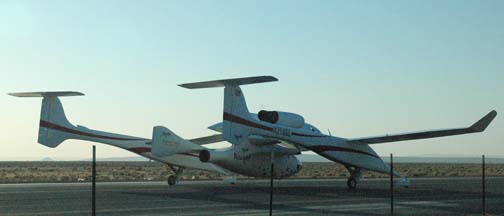 White Knight and SpaceShipOne taxi to Runway 30.
A 1,700-foot clear radius was established around its position on the runway to
protect observers when the rocket engine was armed before take-off.
White Knight and SpaceShipOne taxi to Runway 30.
A 1,700-foot clear radius was established around its position on the runway to
protect observers when the rocket engine was armed before take-off.
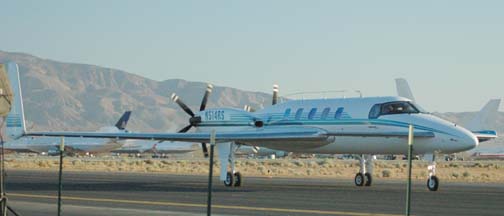 Bob Scherer's Beechcraft Starship NC-51, N514RS serves as "high chase"
on missions of the White Knight and SpaceShipOne. It is one of about nine starships that remain in operation.
Most of the rest have been parked at Pinal Airpark near Marana, Arizona.
Bob Scherer's Beechcraft Starship NC-51, N514RS serves as "high chase"
on missions of the White Knight and SpaceShipOne. It is one of about nine starships that remain in operation.
Most of the rest have been parked at Pinal Airpark near Marana, Arizona.
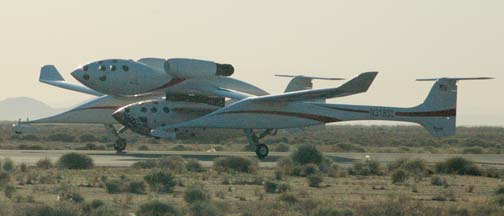 White Knight and SpaceShipOne take off from Runway 30
at 6:45 A.M.
White Knight and SpaceShipOne take off from Runway 30
at 6:45 A.M.
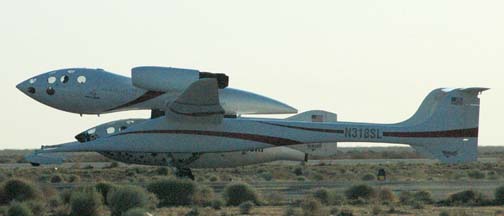 White Knight and SpaceShipOne.
White Knight and SpaceShipOne.
 White Knight and SpaceShipOne.
White Knight and SpaceShipOne.
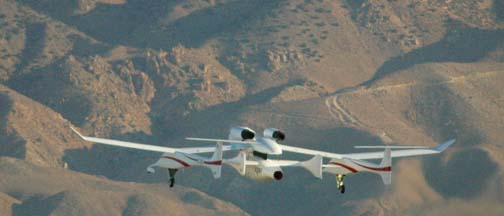 White Knight and SpaceShipOne.
White Knight and SpaceShipOne.
 White Knight and SpaceShipOne circled overhead as they
climbed to 47,000 feet altitude.
White Knight and SpaceShipOne circled overhead as they
climbed to 47,000 feet altitude.
 White Knight and SpaceShipOne
were accompanied by Beechcraft Starship, N514RS during the ascent.
White Knight and SpaceShipOne
were accompanied by Beechcraft Starship, N514RS during the ascent.
 This Dornier Alpha-jet serves as a second high chase. It taxied
out at 6:57 A.M. It was piloted by
Mr. Van der Schueren. Mr. Johnson in the back seat shot video and still photographs of
the White Knight and SpaceShipOne.
This Dornier Alpha-jet serves as a second high chase. It taxied
out at 6:57 A.M. It was piloted by
Mr. Van der Schueren. Mr. Johnson in the back seat shot video and still photographs of
the White Knight and SpaceShipOne.
 White Knight and SpaceShipOne.
White Knight and SpaceShipOne.
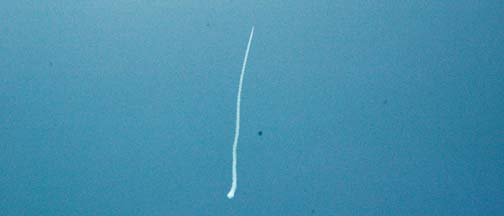 SpaceShipOne ignites its solid fuel/liquid oxidizer rocket engine as
White Knight banks to the left at 7:49 A.M.
SpaceShipOne ignites its solid fuel/liquid oxidizer rocket engine as
White Knight banks to the left at 7:49 A.M.
 SpaceShipOne accelerated to Mach 2.9 (2,150 miles per hour).
Pilot Mike Melvill earned his astronaut's wings when SpaceShipOne climbed through 50 miles
altitude. Shortly before engine cut-off the primary pitch trim control failed.
Melvill switched to the backup pitch trim control.
SpaceShipOne accelerated to Mach 2.9 (2,150 miles per hour).
Pilot Mike Melvill earned his astronaut's wings when SpaceShipOne climbed through 50 miles
altitude. Shortly before engine cut-off the primary pitch trim control failed.
Melvill switched to the backup pitch trim control.
After seventy-six seconds, Melvill cut-off the flow of nitrous oxide oxidizer to the engine as it climbed through 180,000 feet altitude. SpaceShipOne continued to climb in a ballistic arc to an altitude of 328,491 feet. As a result of the control failure, SpaceShipOne did not climb as high as planned and it re-entered outside the intended airspace.
During the re-entry, the rear control surfaces were raised 90 degrees to insure a stable descent. SpaceShipOne accelerated to Mach 2.9 on the way back down. Melvill was subjected to 5 Gs of deceleration force. He reconfigured the control surfaces to begin the glide back to the Mojave Airport at an altitude of 57,000 feet.
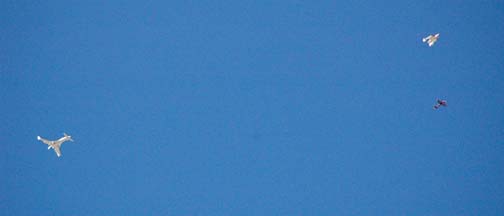 Beechcraft Starship, N514RS and Extra 300, N12DW chase SpaceShipOne as it glides back to the Mojave Airport.
Beechcraft Starship, N514RS and Extra 300, N12DW chase SpaceShipOne as it glides back to the Mojave Airport.
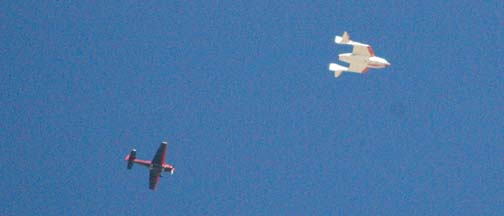 Extra 300, N12DW chases SpaceShipOne as it glides back to the Mojave Airport
at 8:10 A.M.
Extra 300, N12DW chases SpaceShipOne as it glides back to the Mojave Airport
at 8:10 A.M.
 Extra 300, N12DW chases SpaceShipOne as it lands on Runway 30 at the Mojave
Airport concluding the first privately funded manned flight into space at 8:13 A.M.
Extra 300, N12DW chases SpaceShipOne as it lands on Runway 30 at the Mojave
Airport concluding the first privately funded manned flight into space at 8:13 A.M.
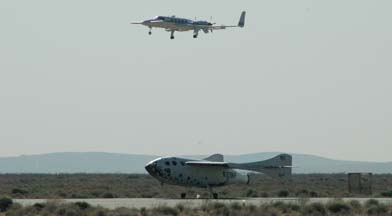 Beechcraft Starship, N514RS chases SpaceShipOne as it lands at
the Mojave Airport.
Beechcraft Starship, N514RS chases SpaceShipOne as it lands at
the Mojave Airport.
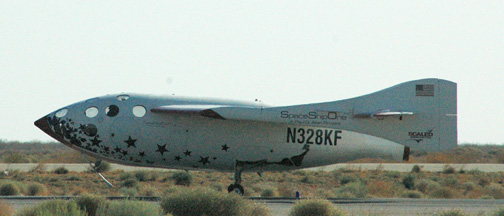 SpaceShipOne lands at
the Mojave Airport 24 minutes and 5 seconds after it was launched from White Knight.
SpaceShipOne lands at
the Mojave Airport 24 minutes and 5 seconds after it was launched from White Knight.
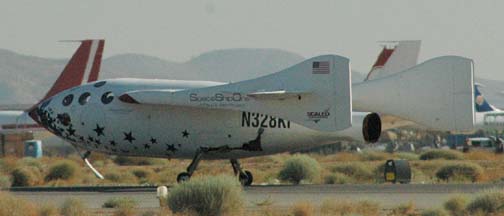 SpaceShipOne lands at
the Mojave Airport.
SpaceShipOne lands at
the Mojave Airport.
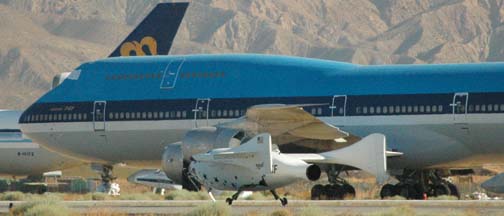 SpaceShipOne lands at
the Mojave Airport.
SpaceShipOne lands at
the Mojave Airport.
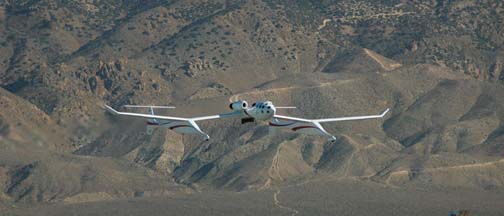 White Knight, N318SL approaches the Mojave Airport two minutes after the
landing of SpaceShipOne.
White Knight, N318SL approaches the Mojave Airport two minutes after the
landing of SpaceShipOne.
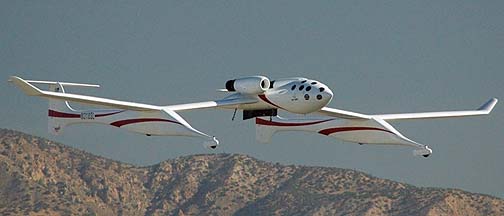 White Knight, N318SL flies over the Mojave Airport.
White Knight, N318SL flies over the Mojave Airport.
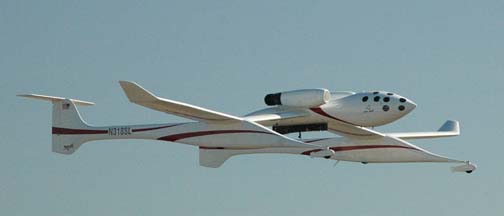 White Knight, N318SL flies over the Mojave Airport.
White Knight, N318SL flies over the Mojave Airport.
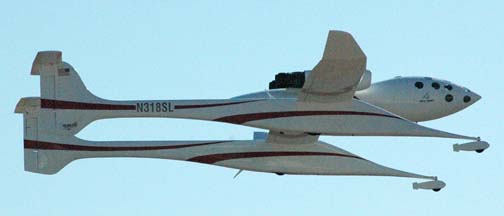 White Knight, N318SL flies over the Mojave Airport.
White Knight, N318SL flies over the Mojave Airport.
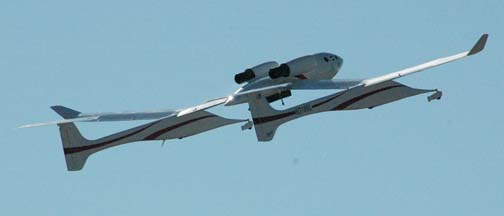 White Knight, N318SL flies over the Mojave Airport.
White Knight, N318SL flies over the Mojave Airport.
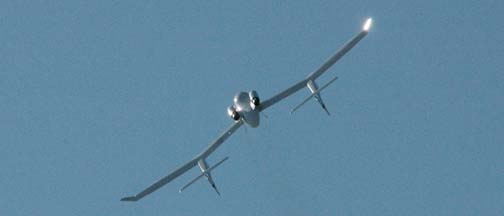 White Knight, N318SL flies over the Mojave Airport.
White Knight, N318SL flies over the Mojave Airport.
 White Knight, N318SL on approach to land on Runway 26 at the
Mojave Airport.
White Knight, N318SL on approach to land on Runway 26 at the
Mojave Airport.
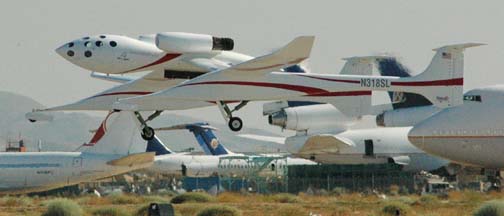 White Knight, N318SL lands at the Mojave Airport.
White Knight, N318SL lands at the Mojave Airport.
 White Knight, N318SL lands at the Mojave Airport.
White Knight, N318SL lands at the Mojave Airport.
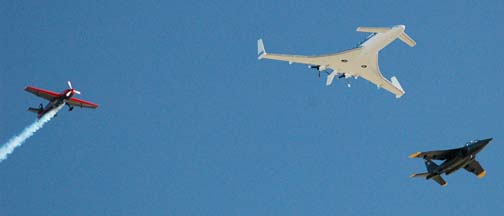 Beechcraft Starship, N514RS, the Alphajet, and Extra 300, N12DW fly
over the Mojave Airport before breaking into the landing pattern.
Beechcraft Starship, N514RS, the Alphajet, and Extra 300, N12DW fly
over the Mojave Airport before breaking into the landing pattern.
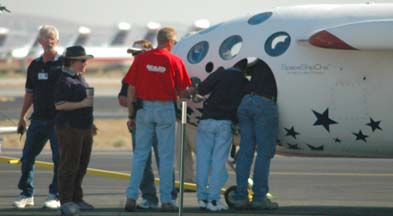 The recovery team examines the cockpit of SpaceShipOne after
the flight.
The recovery team examines the cockpit of SpaceShipOne after
the flight.
 The recovery team examines SpaceShipOne after
the flight.
The recovery team examines SpaceShipOne after
the flight.
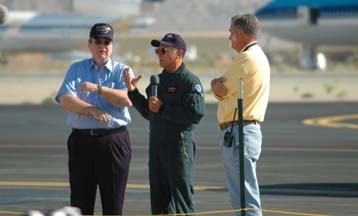 Paul Allen, Mike Melvill, and Burt Rutan discuss the flight and
the promise of future private space ventures.
Paul Allen, Mike Melvill, and Burt Rutan discuss the flight and
the promise of future private space ventures.
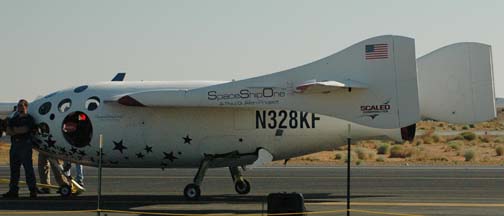 SpaceShipOne acquired a dent on the underside of the rear fuselage
at some point during the flight.
SpaceShipOne acquired a dent on the underside of the rear fuselage
at some point during the flight.
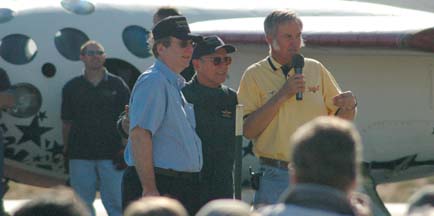 Paul Allen, Mike Melvill, and Burt Rutan discuss
the promise of future private space ventures. When asked if SpaceShipOne was
scalable, Rutan stated "yes" with a certainty that suggested he is already
working on larger versions.
Paul Allen, Mike Melvill, and Burt Rutan discuss
the promise of future private space ventures. When asked if SpaceShipOne was
scalable, Rutan stated "yes" with a certainty that suggested he is already
working on larger versions.
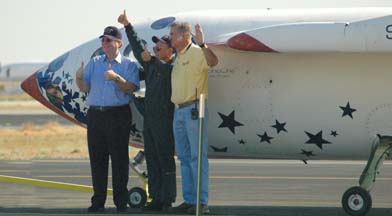 Photo op with Paul Allen, Mike Melvill, and Burt Rutan.
Photo op with Paul Allen, Mike Melvill, and Burt Rutan.
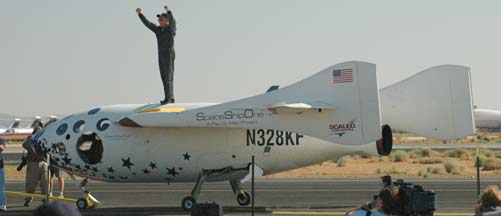 Mike Melvill stands atop SpaceShipOne.
Mike Melvill stands atop SpaceShipOne.
 Mike Melvill atop SpaceShipOne.
Mike Melvill atop SpaceShipOne.
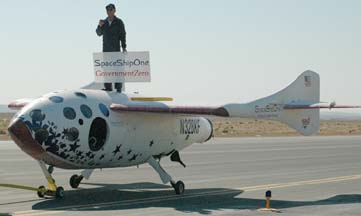 Mike Melvill stands atop SpaceShipOne with a banner reading,
"SpaceShipOne, Government Zero" as it is towed along the taxiway. The scene was reminiscent of
old footage of Chuck Yeager standing on the wing of the X-1 as it was towed around Edwards Air Force Base.
Melvill had a much, much bigger audience than Yeager.
Mike Melvill stands atop SpaceShipOne with a banner reading,
"SpaceShipOne, Government Zero" as it is towed along the taxiway. The scene was reminiscent of
old footage of Chuck Yeager standing on the wing of the X-1 as it was towed around Edwards Air Force Base.
Melvill had a much, much bigger audience than Yeager.
 Mike Melvill stands atop SpaceShipOne as it is towed back to the Scaled
Composites hangar at 8:55 A.M. A lot of data reduction and a big party are sure to follow.
Mike Melvill stands atop SpaceShipOne as it is towed back to the Scaled
Composites hangar at 8:55 A.M. A lot of data reduction and a big party are sure to follow.
 The Mojave Airport is the final resting place for many retired
airliners. Can you spot the North American F-100 Super Sabre, Douglas DC-8, Douglas C-133
Cargomaster, Convair 880, and Convair 990?
The Mojave Airport is the final resting place for many retired
airliners. Can you spot the North American F-100 Super Sabre, Douglas DC-8, Douglas C-133
Cargomaster, Convair 880, and Convair 990?
 Burt Rutan's SpaceShipOne won the Ansari X-Prize on October 4, 2004 for making two flights to
an altitude of 100 kilometers from the Mojave Airport within
two weeks.
Burt Rutan's SpaceShipOne won the Ansari X-Prize on October 4, 2004 for making two flights to
an altitude of 100 kilometers from the Mojave Airport within
two weeks.
Send a message to Brian.
Go to home page of the Goleta Air and Space Museum.